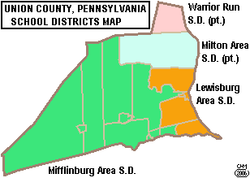| Warrior Run High School | |
|---|---|
 Fragment of WRSD in northern part of Northumberland County | |
| Location | |
 | |
4800 Susquehanna Trail , Union County, Northumberland County, Montour County , 17772 | |
| Information | |
| Type | Public |
| Principal | Nathan Minium |
| Faculty | 41 teachers (2013); [1] 41 teachers (2011–12) [2] |
| Teaching staff | 50.70 (FTE) [3] |
| Grades | 9-12 |
| Enrollment | 664 (2023-2024) [3] |
| Student to teacher ratio | 13.10 [3] |
| Language | English |
| Color(s) | Blue and Gray |
| Mascot | Defenders |
| Website | http://www.wrsd.org/ |


Warrior Run High School is a small, rural public high school located in Turbotville, Pennsylvania. It is the sole high school operated by the Warrior Run School District. It serves the residents of the boroughs of Turbotville, McEwensville and Watsontown. It also serves Gregg Township in Union County, Delaware Township and Lewis Township in Northumberland County; as well as Anthony Township and Limestone Township in Montour County. In 2016, Warrior Run High School reported its enrollment was 479 pupils. [4] Warrior Run High School students may choose to attend Lycoming Career and Technology Center for training in the building trades, automotive technology, culinary arts, allied health services and child care. The Central Susquehanna Intermediate Unit CSIU16 provides the high school with a wide variety of services like specialized education for disabled students and hearing, speech and visual disability services and professional development for staff and faculty.
